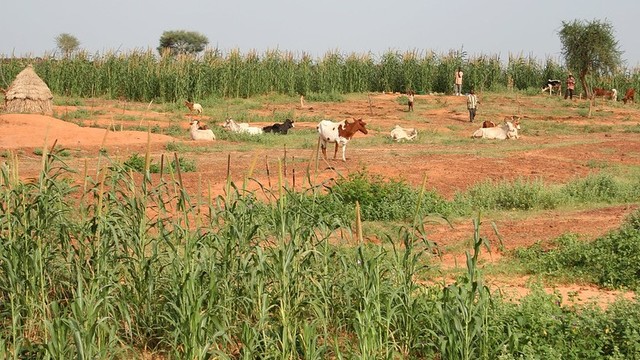How oceans dried out the Sahel
Alessandra Giannini challenges the long-held view that local people were to blame for the great Sahelian drought of the 1970s and 80s – and explains how climate models now show the cause originating in the oceans.


A dust storm looms over the drylands of the Sahel (Photo: Marie Monimart/IIED)
What caused the great Sahelian drought of the 1970s and 80s? For the past 10 or so years, state-of-the-art climate models have consistently shown how the shift from the anomalously wet conditions that characterised the 1950s and 60s, to persistent drought in the 1970s and 80s, actually happened.
There have been two starkly contrasting arguments. The first long-held view points to unsustainable human activity, exacerbated by rapid population growth, triggering a downward spiral of environmental decline. Local people are responsible: they have overgrazed, exceeded the 'carrying capacity' of pastoral land, cultivated 'marginal' agricultural land, and cut wood for fuel.
Stripping away vegetation from the land and degrading the soils may have changed the winds in the region in a way that perpetuated the drought.
The second suggests that the origin of drought is in the oceans, and that industrialisation may be to blame.
But could oceans have really caused the Sahelian drought? As counterintuitive as it may seem there is a simple physical explanation.
Changes in the surface temperature of the oceans
The climate of the semi-arid Sahel is characterised by extreme seasonality. For most of the year, it does not rain at all. Streams and ponds run dry, and even the majestic Niger river hesitates.
Then, as the sun passes overhead and land warms, the monsoon presses northward, feeding moisture-laden air, because of its oceanic origin, inwards to the dry continent, bringing rain – at times torrential – for three to four months, before retreating southward again.
For rain to occur the air that rises needs to be moist. As it rises, a parcel of air cools and condenses the moisture in it, which falls out as rain. The ocean is at an advantage compared to land, because parcels of air that evaporate from the ocean are rich in moisture.
In contrast, especially at the beginning of the rainy season, a parcel of air rising from the dry surface of the semi-arid Sahel will have little moisture of its own, apart from that which has been imported from the ocean, thousands of kilometres away, with the monsoon.
Subtle changes in the surface temperatures of the oceans can upset this balance.
A warmer ocean may become wetter, by evaporating more and raining more locally, essentially drawing moisture away from the land.
By contrast, a cooler ocean would feed less moisture to the monsoon, and end up drying the land. Both these phenomena are implicated in the drying of the Sahel that emerged in the early 1970s.
Greenhouse gas-induced warming of the oceans, most notably the Indian Ocean, began to emerge at the same time that the North Atlantic Ocean stayed relatively cool, due in major part to the influence of sulfate aerosols that reflect solar radiation. These sulfates were the product of emissions from long-standing industrialisation in Europe and North America.
Evidence from climate modelling – testing the theories
Global models of the atmosphere simulate the large-scale climatic shift towards prolonged drought in the Sahel when run over 20th century observations of global sea surface temperatures only, that is, given no information on local land use change. 'Coupled' models – simultaneously simulating changes in the atmosphere and ocean – produce the same pattern. This confirms the influence of the oceans in the changing rainfall trends in the Sahel.
What is less clear is how far anthropogenic emissions of greenhouse gases and aerosols from industrialisation have caused these changes as the 'coupled model' simulations typically include our best estimates of both natural and anthropogenic influences.
A return to local knowledge?
Future projections of Sahelian precipitation are uncertain – but this should not come as a surprise, given the complex processes required to interpret 20th century variations in climate patterns.
Nevertheless, it seems plausible that, as all oceans (including the North Atlantic source of monsoonal moisture) are warming, the Sahel could continue to get wetter for the foreseeable future.
What is intriguing is that if the current trend toward more intense but less frequent precipitation continues, the return to 'local knowledge' spurred by the desertification discourse that blamed the Sahelian people for drought could prove critical to adapt to climate change: sustainable land management practices, including agroforestry and soil and water conservation, use rainfall more effectively, reducing run-off and favouring infiltration that recharges aquifers.
These sustainable practices may serendipitously prove to be exactly the adaptation strategy needed against the more volatile patterns of rainfall that are already emerging.
Alessandra Giannini (alesall@iri.columbia.edu) is a research scientist at the International Research Institute for Climate and Society, a unit of the Earth Institute at Columbia University.
Desertification in the Sahel: local practice meets global narrative, chapter in The End of Desertification? Disputing environmental change in the drylands (2016), available to purchase from Springer, 560 pages, eBook (ISBN: 978-3-642-16014-1)



